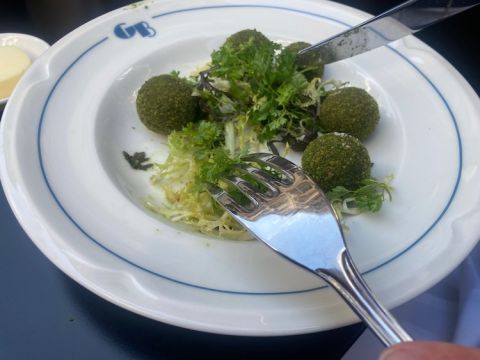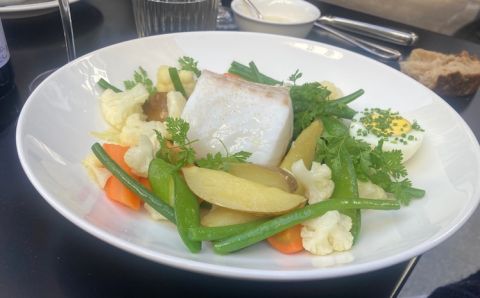If you agree with Jancis and me that the only correct way to spend three hours in Paris, hours that happen to fall between noon and 3 pm, is to sit outside in the sunshine at a very good new brasserie, then I have just the address for you.
The address itself is 6 rue de Bastille, an address that may be well known to Parisophiles as the little street that is home to Bofinger, the famous Alsace brasserie, since it was opened in 1864 by Frédéric Bofinger, a refugee from that then-war-torn region. That vast brasserie occupies numbers 5 to 7 across the street while number 6 has been home since June 2021 to the Grande Brasserie.
This site was for some time known previously as Le Petit Bofinger but when Groupe Flo, the owners of Bofinger and many other brasseries besides, decided to put it up for sale they stipulated one condition: that the new owners create a new name for it, disassociating it from Bofinger forever.
This did not appear a problem to its new owners, the New Zealander Drew Harré and his Spanish business partner Juan Sánchez, who have already worked their magic on the likes of Cosi (a brand and a style of food that I could envisage worldwide), Semilla, Fish and Freddy’s as well as a wine shop, La Dernière Goutte. What concerned them and their team once negotiations were finalised was the enormous amount of detritus that had accumulated inside the brasserie over the years.
Eventually, it was all cleared out and, after a delay imposed by COVID restrictions, the newly named Grande Brasserie (a name that is so simple and so evocative I could not believe it had not been taken) opened when the capital reopened. But with one significant and major improvement.
In line with all the other cafes, brasseries and restaurants in France, outside seating was condoned without special permission and it was here that we sat. First of all, on a couple of chairs facing out onto the rue de la Bastille watching Bofinger’s chefs enjoy a moment before lunch service, and then across the small passageway left for pedestrians on a sequence of tables for two and four as we were joined by an old friend.
Rue de la Bastille is a good place to sit: it is barricaded at the far end that gives onto the Place de la Bastille (see our main picture), and is only one-way from there. Like so many other streets in Paris, the biggest danger to pedestrians now comes from the rather nonchalant cyclists.
It was sitting in the sunshine that HRH was able to indulge herself in what being in Paris means to her by ordering a bottle of Sancerre because she so closely associates this wine with the City of Light. But this bottle of the 2019 vintage from Domaine Vacheron (€52) was very different from the much skinnier vintages of yore: global warming has made today’s Sancerres much richer than their predecessors. With this, we nibbled some plump Kalamata olives and some delicious, warm gougères.
Harré, Sánchez, their Canadian-born chef Francis Jacques and their energetic general manager Adrien Spanu were faced with the interesting challenge of writing a brasserie menu for the 2020s when confronted with the rising cost of labour and only a small kitchen off the main dining room. The menu offers dishes that I have always associated with a ‘grand brasserie’. It is almost impossible in a brasserie menu of five starters, four main courses and four desserts not to fall over a classic, a dish that one has craved during the long period when travel to Paris was out of the question.
In fact there are nine starters because in the top right-hand corner of the menu there are four more under the heading ‘fruits de mer’. These include the very French bulots (whelks served in France with mayonnaise), large prawns, and two kinds of oysters: half a dozen specials from Isigny (€13) and half a dozen Gillardeau No 3s (€20), a dish I associate with eating in a Paris brasserie as much as Jancis associates Paris with a glass of Sancerre. My No 3 oysters were plump and delicious, served and enjoyed with just the right amount of juice from a freshly squeezed lemon.
Our guest ordered a virtuous salad of haricot beans, shallots and chervil (€12), which revealed someone with a sharp knife in the kitchen, and another first course that revealed far more dexterity and creativity. This was described as ‘cromesquis of snails, butter and garlic’ (€15) and what emerged were six green spheres that had been deep fried and contained all of these ingredients – a crisp, modern twist on an old-fashioned brasserie favourite.
Main courses included a steak tartare with frites (€24); a ‘grand aioli’ with particularly fresh cod, mayonnaise, potatoes and a wide variety of well-cooked vegetables (€26); and the ‘menu du jour’ that was a steal at €24 for a classic tronçon of turbot and a chilled tomato soup as a starter. In the end I chose a dish of veal kidneys with gratin dauphinoise which, as a combination, proved extremely comforting (€28) – not that I really needed comfort in these most agreeable circumstances.
But it was the presence of one dish on the dessert menu that made me appreciate where I was sitting and how much I enjoyed the whole experience. This was described as ‘île flottante, crème anglaise et caramel’ (€11) and was a classic of simplicity: eggs, a lovely crème anglaise and the added sweetness of caramel mixed through it. It was excellent, although the sliced almonds on top may have irritated any purist; the crème brûlée was perfect in texture and flavour too, and was served in the correct, shallow dish. Lunch for the three of us, with a couple of espressos, a bottle of that Sancerre and a bottle of Serol’s 2020 Côte Roannaise very fruity Gamay came to €240 in total.
Had we sat inside, we would have enjoyed a different view: of old posters and of a rather splendid floor. But whatever the weather, this address is well worth adding to any list of brasseries in this charming city.
Grande Brasserie 6 rue de la Bastille, 75004 Paris; tel: +33 (0)9 75 80 99 72. Open Wednesday to Sunday.

















